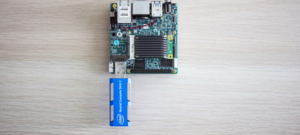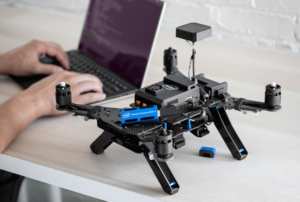
Intel Aims to Simplify AI with ‘Neural Stick’ Update

(image source: Intel)
Intel today unveiled an upgraded Neural Compute Stick that it claims will dramatically simplify the roll-out of neural network inference applications in drones, IoT, and edge devices.
It may look like a standard USB thumb drive, but the Neural Computer Stick 2 (NCS2) that Intel unveiled today at its AI conference in Beijing is much more than that. In fact, the little device boasts a Myriad X vision processing unit (VPU) manufactured by Intel’s subsidiary Movidius, which powers a neural network used for predictive applications.
Intel’s NCS devices are designed to simplify the roll-out of AI technologies in edge devices. A data scientist equipped with a laptop can convert pre-trained deep learning models onto the NCS device, which plugs into any standard USB 3.0 port.
The NCS is designed primarily (but not solely) for computer vision and related applications. The neural network running in the NCS enable developers to build applications that can identify and classify objects at a high level of accuracy.
Intel says that since it launched the original NCS in 2017, more than 10,000 developers have used the technology — along with the associated Intel Distribution of OpenVINO toolkit — to build AI applications that tackle real world challenges.
For example, one of those developers, Peter Ma, created a program called Clean Water AI to detect harmful bacteria in water, as well as the BlueScan AI program to detect skin cancer, according to Intel. The chip giant also cited developer Christian Haschek, who used the NCS to build a Raspberry Pi-based system that scans the internet for illegal images of children and reports them to Interpol. Another is Adam Milton-Barker, who used NCS to build a program that translates American Sign Language to text in real-time.
“The first-generation Intel Neural Compute Stick sparked an entire community of AI developers into action with a form factor and price that didn’t exist before,” Naveen Rao, Intel corporate vice president and general manager of the AI Products Group, stated in a press release. “We’re excited to see what the community creates next with the strong enhancement to compute power enabled with the new Intel Neural Compute Stick 2.”
Intel says the NCS2 is 8x faster than the first generation NCS, which should allow customers to build systems that feature faster inference processes, or ones that incorporate more data points. It also says it has built new optimizations for the OpenVINO toolkit, which will allow developers to write their code once and deploy it across many architectures.
Intel made the announcement at its AI DevCon event in Beijing, which is being attended by more than 1,000 developers today and tomorrow. In addition to the NCS2, the company is talking about other offerings that are part of its AI strategy, including:
- The upcoming Cascade Lake scalable Xeon processor that will feature its Optane DC persistent memory and a set of new AI features called Intel DL Boost. Intel expects Cascade Lake to ship later this year and ramp up in 2019;
- The array of solutions under its Vision Accelerator Design Products, including Intel Movidius VPUs and the Intel Arria 10 FPGA. All of its accelerator solutions build on the OpenVINO toolkit;
- The upcoming Spring Crest neural network processor (NNP) that will be available in the market in 2019 through the Intel Nervana organization. Intel says its Nervana NNP family leverages compute characteristics specific for AI deep learning, such as dense matrix multiplies and custom interconnects for parallelism.
Related Items:
Inside Intel’s nGraph, a Universal Deep Learning Compiler
New AI Chips to Give GPUs a Run for Deep Learning Money
Intel Details AI Hardware Strategy for Post-GPU Age




























